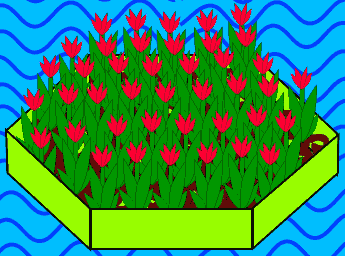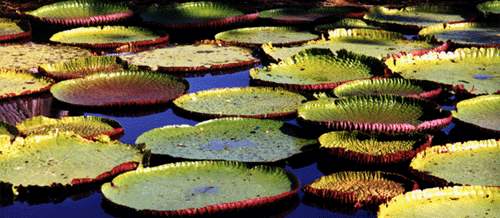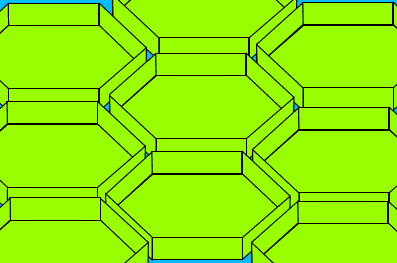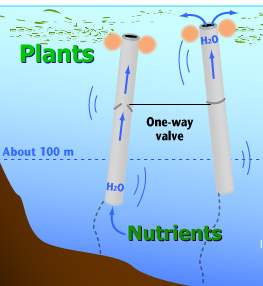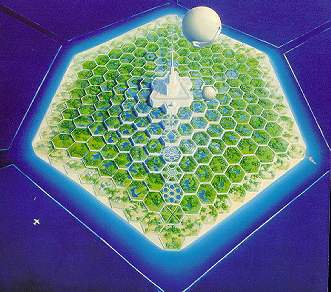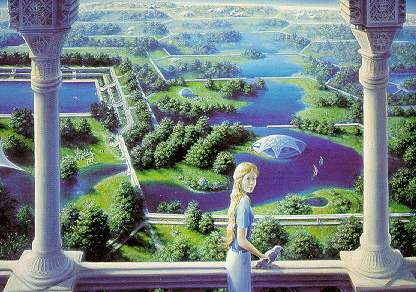|
Many of the world's bodies of water represent ecological wildernesses. The main problem is that all the food sinks to the bottom - where there is no light, and life is challenging. In very shallow waters, plants - such as kelp - can span this distance. If the sediments are stirred up nutrients can go into solution, creating algal blooms, allowing animal life to exist. Elsewhere, life tends to be scarce. It seems like much of the planet's surface is going to waste.
Using such bodies of water for practical purposes would be easier if their
surfaces could be employed. With a small body of water, it may be possible to stretch a skin over the entire surface. If this is possible, it is probably the simplest solution. The skin would consist of a network of cables and floats, to provide structural support - probably with a membrane suspended on or above the surface. However, on larger scales, it may not always be practical to stretch cables right across a body of water. Tesselated rafts are an alternative solution.
These would be constructed from waterproof, stiff material.
The rafts would fit together like this:
They could be simply bolted together - or attached to each other like this:
The motivation for the loose attachment is to allow for motion caused by variable water levels and tides. The attachments should be sufficient to prevent a punctured cell from sinking - so it can be repaired or replaced and does not sink to the bottom. Crops could then be grown on top. Fertiliser and water would be applied from above. Windbreaks could be applied to the raft sides, if required - or the rafts could be domed over, to form greenhouses. The rafts could be of any size. The main disadvantage of making them too big is that the benefits of modularity are lost. Build them too small, and construction and manufacturing costs increase and their individual stability goes down.
InversionThe basic idea works either way up:
These are both good patterns, but pneumatically stabilised structures probably have more going for them:
Driving problemAt the moment, floating platforms are relatively expensive - and the resulting surface is of substandard quality.Harbour walkways and floating breakwaters are constructed this way, but not much else. One driving problem many see as most likely to result in these kinds of platform being constructed on a large scale is floating airports. Sometimes costal cities can't spare space for an airport, despite the need for one near the centre of town. Demand for additional coastal real estate has already produced the Kansai International Airport at Osaka and the artificial islands in Dubai - though these do not float. In the future, floating platforms could also be used for real estate for coastal cities, hotels and harbors.
Commercial useSeveral companies are promoting the use of this technology. One of them is [Float inc.]. They use concrete tubes as containers for their air columns - and connect their air chambers.The idea behind the connections is to allow incoming ocean-borne loads to be distributed over large areas of the structure - and allow turbines to be driven by the resulting air flow in order to generate electricity. Here is one of their prototypes:
Ocean reclamationIt seems likely that our descendants will wind up covering much of the oceans, to increase the extent of the planet's habitable zone.As technological progress continues, the construction and maintenance costs of ocean platforms seem likely to decrease. Prices may eventually drop to the point where land on ocean platforms is cheaper than other real estate - as a reflection of their relative desirability to customers. At this stage, such platforms may come to be used for agricultural purposes. It seems reasonable to expect that the resulting greater potential for living things on the planet will allow its biological systems to increase in scale, and improve the ability of life to buffer itself against natural disasters and ecological stresses.
AquacultureOcean reclamation seems likely to take place - in part - via aquaculture schemes. Aquaculture is a rapidly expanding area of technology, used to farm bodies of water - and the oceans. Fish are currently the main product. However plants and algae are also produced.Seawater is an inhospitable environment for most plants - but numerous seaweeds are already adapted to it. Nutrients placed into water tend to diffuse away - but plant root balls could be placed in porus nets designed to retain them. The ocean itself often lacks nutrients - but these may be supplied by distribution schemes - or even obtained locally from the sea bottom. One proposed sea-floor nutrient-extraction schemes involves pipes that pump up water from the sea bed, driven by wave or solar power.
Widespread ocean farming - and the associated use of ocean wave energy converters - would have the effect of calming the surface of the oceans, a useful prelude to the wide-scale deployment of other surface skinning technologies - such as rafts.
Marshall SavageMarshall Savage was one of the first to lay out serious plans for ocean reclamation.He did this in a book: "The Millennial Project: Colonizing the Galaxy in Eight Easy Steps", published in 1992. He proposed using areas of the ocean near the equator, to avoid the worst atmospheric disturbances and storms. Here is what he had to say about the hexagonal pattern:
The "Purple Bubble Raft Snail" is a snail of the type which Marshall is referring to. Some pictures illustrate his concept:
Marshall Savage also pointed out that the close proximity to a body of deep water might make Ocean Thermal Energy Converters a potential source of energy. Before colonisation of the ocean gets underway, it seems likely that lakes and reservoirs may be colonised. Many reservoirs are enclosed today - this prevents pollution and plant growth. In the case of large reservoirs covered with floating platforms, strict controls would be needed, to ensure that the water was not used for waste products.
This involves placing a huge dam across the Strait of Gibraltar, and lowering of the surface of the Mediterranean Sea. More details are on this project's own page.
The planet's septic tankUltimately, ocean reclamation seems likely to transform the character of the oceans completely. It seems likely that they will turn into a planetary sewage system - and consequently that they will support entirely different ecosystems to those which they sustain today.
LinksAquarius risingOn The Waterfront Review of Marshall Savage's Millennial Project Review of Marshall Savage's Aquarius Oceania - The Atlantis Project Oceania - Seacell Oceania - Oracle Oceania - Images Hexagonal raft Artificial island Ocean reclamation the building of artificial islands Nexus: Mobile Floating Sea City - Tsui design and research, inc. Float inc / Offshore Ports Euphlotea Seasteading Build new Atlantis Operation Atlantis and the Radical Libertarian Alliance: Observations of a Fly on the Wall Very large floating structure Pneumatic Stabilized Platform Floating airport Freedom Ship Ocean Wave Energy Company N55 floating platform Connect-A-Dock LakeMarineConstruction Aquaculture 250,000 bottles:amazing recycled Mexican island paradise Stabilized floating platform - Patent Stabilized floating platform assembly - Patent Giant Ocean Tubes Proposed as Global Warming Fix Giant ocean-based pipes could curb global warming: scientists James Lovelock's plan to pump ocean water to stop climate change Plan to Dump Iron in Ocean as Climate Fix Attracts Debate Ocean Fertilization 'Fix' For Global Warming Discredited By New Research Atlantropa Gibraltar dam
|
